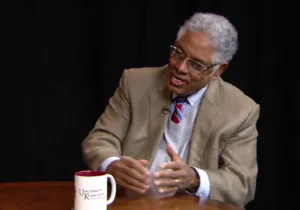From at least the mid-twentieth century, all the way to the early 2000s, popular visions of technology’s role in the future were marked by sunny optimism. Technology, it was said, would raise the standard of living, topple once and for all the old information-hoarding hierarchies and monopolies, and unite people around the world in one harmonious democratic celebration. Today, no one even pretends to believe such a future is imminent. What happened?
Daron Acemoglu and Simon Johnson suggest an answer in Power and Progress: Our Thousand-Year Struggle Over Technology and Prosperity. Acemoglu and Johnson, both professors at MIT, argue that the “secret sauce of shared prosperity in the decades following World War II” was “a direction of technology that created new tasks and jobs for workers of all skill levels and an institutional framework enabling workers to share productivity increases with employers and managers”—in other words, a set of policies promoting the development and growth of technologies that supported and enriched, rather than displaced, workers. But in recent decades, we’ve followed a different recipe, so to speak, one that has empowered employers, managers, and other elites while condemning everyone else to stagnating wages, precarious employment, and a Panopticon-like corporate invasion of our privacy.
As far as sauces go, Acemoglu and Johnson’s is rather bland, but it comes with an intriguing garnish: an emphasis on the sheer contingency of our technologies’ trajectory, and its broader political and social impact. “Technology’s bias against working people,” they argue, “is always a choice, not an inevitable side effect of ‘progress.’” For Acemoglu and Johnson, deterministic thinking about technology has crippled our ability to address today’s problems, and blinded us to how our history could have been different.
Though Acemoglu and Johnson never quite put it this way, their arguments reveal a surprising feature of technological determinism: its appearance in both an optimistic and a pessimistic flavor. The former insists that “[n]ew technologies … expand human capabilities and, when applied throughout the economy, greatly increase efficiency and productivity” and promises that “[s]ociety will sooner or later find a way of sharing these gains.” Besides the obvious rejoinder that technology has victims today, regardless of its eventual benefits, this view obscures the possibility that technologies will be directed even in the future to benefit only the elites in tech and business, who can absolve themselves of responsibility with the assurance that down the road, the out-of-work proles will find something to do. The pessimistic strain of technological determinism, meanwhile, sees modern technology’s use for “automation, surveillance, data collection, and advertising” as unavoidable. Technology’s trajectory cannot be altered, the argument goes, and so there’s no point in wishing that it could have instead promoted individual agency and widespread affluence—or in agitating for political reform.
As the subtitle suggests, Power and Progress only makes this argument with great circumlocution. The book’s ultimate topics of interest are the rise and fall of postwar abundance in addition to assessments of automation, AI, social media, and other timely topics. But, before these are discussed, the reader faces a full millennium, and hundreds of pages, on not just the Industrial Revolution, but also its agricultural predecessor, the construction of the Suez Canal, American Reconstruction, and many other largely irrelevant matters. For Acemoglu, this method continues the style of his previous books, such as Why Nations Fail, which similarly hid a compelling thesis about state development behind mountains of cocktail-party-ready historical trivia. But it marks a break from the concision of Johnson’s previous books, such as Jump-Starting America, on the importance of breakthrough science to economic growth, and 13 Bankers, a history of the 2008 financial crisis. Vague musings on the nature of power and ideological influence are similarly tiresome.
Though Acemoglu and Johnson give much attention to particular technological trends, economic puzzles, and policy challenges, two broader points in their emphasis on choice and contingency in the history of technology deserve particular attention. First, they make the important point that we didn’t have to squander so much talent and money in recent decades on industries and products that devalue humans, violate our privacy, and fuel an advertising arms-race for our attention. With the right incentives, policies, and investments, perhaps we could have instead gotten clean energy, better transportation, and other substantive innovations, along with well-paying jobs across social classes. Acemoglu and Johnson’s rejection of inevitability is a useful reminder that discrete poor choices got us into this mess, and that a new approach to political economy could get us out.
The emphasis on choice and agency seriously errs, however, when Acemoglu and Johnson use it to justify a stance of principled agnosticism about technology’s value: “Technology does not have a preordained direction, and nothing about it is inevitable.” “Digital technology,” for example, “is not pro-democratic or antidemocratic”; social media can topple dictators and promote democracy, as in the Facebook- and Twitter-facilitated Arab Spring, but it can also promote misinformation, extremism, and hate speech. Similarly, they note, the early radio gave a greater platform to not just President Roosevelt, but also the demagogic Father Charles Coughlin and the Nazis. The sensible conclusion, surely, is that technology is good when used well and bad when used poorly, and so we should give using it well a try. What could be more obvious?
If only it were so. Tempting as this way of thinking is, it obscures technology’s inherent transformative power, which is never just a matter of how it is used. Technology is more than just tools we apply to our environment at will; it determines what our very environment is, shaping the content of our thoughts and actions, our ways of thinking, our modes of interacting with everything beyond ourselves, and even the boundary between what is properly “ourselves” and what is “beyond.” What common laments about misinformation and the rejection of “trusted media sources” miss is that liberal democracy plus the Internet is not the same system, just with faster communication and a larger menu of beliefs to select from; it is a new system in which the older modes of authority, legitimacy, and consensus risk becoming incomprehensible. Against the authors’ overriding insistence on our own agency, and our freedom to use technology for good or ill, Marshall McCluhan’s warning remains apposite: “Our conventional response to all media, namely that it is how they are used that counts, is the numb stance of the technological idiot. For the ‘content’ of a medium is like the juicy piece of meat carried by the burglar to distract the watchdog of the mind.” The world with the atom bomb is a different world from that without, regardless of whether the white hats drop it on the black hats or vice versa.
A clearer understanding of technology would recognize, to modify Churchill’s quip about architecture, that we shape our technology, and thereafter our technology shapes us. In their meandering way, Acemoglu and Johnson are right to reject the myth of unstoppable “progress” peddled by its beneficiaries. But to do so, only to exaggerate our control over technology once we have unleashed it, is simply to replace one myth with another, perhaps even more dangerous, one.
Power and Progress: Our Thousand-Year Struggle Over Technology and Prosperity, by Daron Acemoglu and Simon Johnson (PublicAffairs, 560 pp., $32)






 Sponsor a student for Christianity & National Security 2024
Sponsor a student for Christianity & National Security 2024